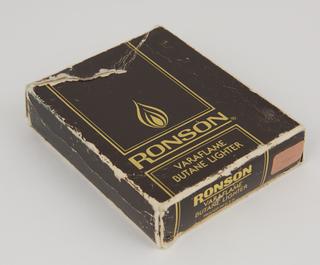
Box of ‘Rupee Tändstiikker’ matches, Norway

![[One only of] Three Boxes Rupee T?ndstiikker'; made at](https://coimages.sciencemuseumgroup.org.uk/485/863/small_thumbnail_smg00297284.jpg)

![[One only of] Three Boxes Rupee T?ndstiikker'; made at](https://coimages.sciencemuseumgroup.org.uk/485/863/medium_smg00297284.jpg)
Box of ‘Rupee Taendstiikker’ matches, sulphur-dipped and made with white, also known as yellow, phosphorus, box decorated with Indian rupee coins, produced for export to India, made at Christiania Taendstikfabrik, Heggedal, Norway, 1874-1895
These matches were produced at the match-making factory ‘Christiania Taendstikfabrik’ in Heggedal, Norway. The company produced matches between 1874 and 1895, when the factory burned down, and exported them to England, India, Australia, and the US. This box is decorated with rupee coins and was most likely intended for export to India.
Matches are arguably the most revolutionary innovation in the development of fire-making methods. After inventors had for many years unfruitfully experimented with different mixtures of self-igniting substances, British pharmacist John Walker invented the first successful friction match in 1826. Coated with sulfur and tipped with a mixture of antimony sulfide, chlorate of potash, and gum, it was ignited by being drawn over a strip of sandpaper. In 1830, French chemist Charles Sauria replaced the antimony sulfide with white phosphorus.
After this, match-making became a popular business. Like most factory work, making matches was a tedious and poorly paid task. The work was particularly dangerous due to the poisonous white phosphorus causing a condition called ‘phossy jaw’, which destroyed the bones of the jaw, could lead to brain damage, and was often fatal.
This object is part of the Bryant and May fire-making collection, which used to be displayed in a private museum within the Bryant and May match-making factory’s offices. The collection comprises around 1200 objects, dating from the Stone Age to the early 20th century that illustrate the variety of tools and techniques humans across the world have used to create fires.
The collection was mostly acquired by the ornithologist and fire-making enthusiast Edward Bidwell and cared for by the collector Miller Christy. Bidwell collected between the late 19th and early 20th century – when Britain's colonial power was at its peak. Tracing the objects’ provenance is therefore difficult and part of the long and problematic history of colonial exploitation.
Details
- Category:
- Firemaking
- Object Number:
- 1937-682/2334
- Materials:
- wood (unidentified) and cardboard
- type:
- box - container
- credit:
- Wilkinson Sword Ltd.




